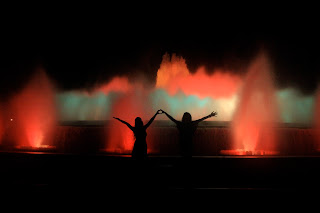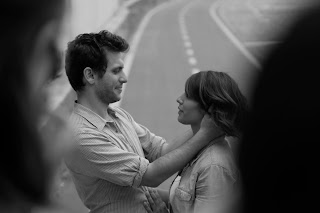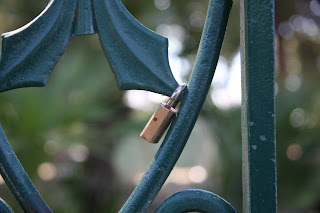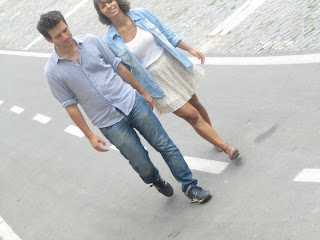This picture upholds the technique of a silhouette. Because the background is so lit up, you can only see the outline of the people. This makes for a dramatic picture and the shapes are more important than their exposure. This is similar to the picture I took in Barcelona of my friends standing in front of the magic fountain.
Sunday, July 31, 2011
gelato jenna - my photo - barcelona magic fountain
I took this picture in Barcelona, Spain of my two friends making a heart with their hands in front of the Magic Fountain. Although it is a silhouette, I still had to set my ISO fairly high because it was so dark out. The shutter speed was set at 1/160 and the diaphragm was set at 5.6.
gelato jenna - herbert list
This picture was taken in Switzerland by Herbert List. I like the depth of field in this picture. The aperture was probably opened fairly wide to have the background blurry. I also really like the shape of the sun glasses. The curves pull my eye around the picture.
Bon Bon
This is my photo of one of the statues in Villa Borghese. I think it shows quite nicely that Superman is superior to Batman.
Wednesday, July 27, 2011
Tuesday, July 26, 2011
gelato jenna - technical aspect
I took this picture (as well as the other picture I uploaded) in monochrome (black and white) setting on my camera. To do this I went into "picture style" in my camera. There are several different options available including: landscape, portrait, and monochrome. Although you can't change this picture back to color if you take it in monochrome setting, I feel as though taking a picture in black and white turns out better than editing one from color to black and white.
gelato jenna - my photo
This is my favorite picture I took in class. I like the leading lines in the background and how there is a framing created with the blur of closer objects. The picture was taken at 1/1600 shutter speed with a diaphram of 4.0.
gelato jenna - my photo
Trent Parke captures box jelly fish in Australia. I am interested in this picture because I've been to Australia a couple of times and we were warned about these deadly creatures. I enjoy the the lines that imply movement and take this 2d picture to a 3d one.
Diane Arbus- GoldPic
Diane Arbus was a seminal figure in documentary photography. Her subjects were often members of society's fringe - an odd, discomforting and new topic for most viewers in the 1950s and 60s. She violated all previously implied "polite distance" rules between herself and those she shot, getting as close as she felt was warranted.
Arbus's photos stood out to be because they were simple shots of people and not a lot in the backgrounds. The majority of her photos seemed depressing to me.
Richard Avedon by GoldPic
Richard Avedon was born in New York on May 15, 1923 of russian-jewish immigrant parents.
He attended Dewitt Clinton High School in the Bronx, but never completed an academic education. In 1940, at age 17, Avedon dropped out of high school and joined the merchant marine's photographic section, taking personnel identification photos. Later, he went on several missions to photograph shipwrecks.
He attended Dewitt Clinton High School in the Bronx, but never completed an academic education. In 1940, at age 17, Avedon dropped out of high school and joined the merchant marine's photographic section, taking personnel identification photos. Later, he went on several missions to photograph shipwrecks.
I liked this photograph because it was really different and stood out to me.
Three Photos From Monday
I like this photo because I think the focus is most drawn to the eyes of the lion.
I like this photo because the positioning of the arm of Batman is very prominent. It adds interesting lines to the picture.
I like this photo because the subject that is most in focus is not in the center of the photo.
Robert Mapplethorpe - Kenz
Robert Mapplethorpe was an American photographer, known for his large-scale, highly stylized black and white portraits, photos of flowers and nude men. The frank, homosexual eroticism of some of the work of his middle period triggered a more general controversy about the public funding of artworks.
Herbert List - Kenz
This picture was taken by Herbert List, who was a German photographer who worked for magazines like Harper's Bazaar, Life, and Vogue. He is known for his stark black and white photographs as well as photographing nude males in places such as Italy and Greece. He is a very influential photographer who has impacted other greats such as fashion photographer Herb Ritts. Many of the photographs that I looked at were composed of two subjects in the foreground. In this case there are two pairs of sunglasses but other photos of his include two people, two bicycles, two heads, or two statues. I like the use of two different pairs of sunglasses and the curiosity it presents of who they belong to. The image gives the notion that is could be a couple in love on a romantic get away with the background scenery.
Picture taken with square camera - Kenz
This picture was taken with a square camera and I like how everything is in focus except the foreground of what appears to be where the cars are. I like the vanishing point aspect of this photo as well.
Temperature effects - Kenz
This picture demonstrates the different effects of color temperature. The color temperature of a light source is the temperature of an ideal black-body radiator that radiates light of comparable hue to that of the light source. Color temperature is conventionally stated in the unit of absolute temperature, the kelvin, having the unit symbol K.
Color temperatures over 5,000K are called cool colors (blueish white), while lower color temperatures (2,700–3,000 K) are called warm colors (yellowish white through red).
Shutter Speed - Kenz
I took this when I was the passenger on a Vespa in Interlaken this weekend. I took it while we were moving so the blurriness shows that the shutter speed was not quick enough to focus the entire wall. The blurriness in the foreground adds a nice effect.
Emphasizing color - Kenz
I took this photograph down by the Tiber River. We were told to maximize the color of the flower so I used a Telephoto lens. I like how the purple of the flowers stand out. I also like how the background is blurry due to the smaller depth of field.
Class with Andrea Ruggeri - Kenz
Although this picture is a little overexposed, I kind of like it that way. I like how everything is bright including the background. And it helps in making them stand out. The subjects are great models and this was taken when we were practicing photographing something in motion so they were walking towards us.
Annie Leibovitz Photo - Kenz
This is a picture taken by Annie Leibovitz, she is an American photographer who has worked for Rolling Stones and Vanity Fair. It was in the 1980's when she introduced a new style of lighting and her use of colors and poses that landed her the job at Vanity Fair. I love the lighting and the haziness in the background with the stiff pose of the subject. She is a noted photographer because in 1991 she mounted an exhibit at the National Portrait Gallery where this picture above was shown. She was the first women to show there.
Dantheman
I took this picture down by the tiber river in class last week. I just love the color and detail of the flowers in this photo. Not to mention, the depth of field was also portrayed.
Dantheman
The focus of this picture was to capture the blue of the construction in the background. Although the picture is underexposed, I felt like I did a decent job capturing the blue.
Dantheman
This picture was taken in class at the Villa of Borghese. The professor asked us to try and capture the expression of this statue. Although my horizontal lines aren't perfect, I think I capture the expression very well. I found the expression to be very strong.
Dantheman
The professor asked us to take a picture while focusing on the statue. I like that in my picture the statue is the main focus but the two similar buildings in the background are symmetric.
Monday, July 25, 2011
Jan- Arm (Jul 25)
This is a picture that I took of a statue. Since the professor told us to focus on just the arm and hand, I like how the background looks dark, making the statue stand out more than it would if you would actually see the green leaves.
Jan- Water (jul 25)
This is an image I took in Piazza del Popolo. I like how I captured the lady taking a picture while you can actually see the drops of water coming out of the lion's mouth.
Jan-Judging (Jul 25)
From the angle that I took this picture, it seems as though the statue in the background is actually judging Batman. The expression on his face makes it seem as though he disapproves whatever Batman is doing.
Sunday, July 24, 2011
On site class
On Monday July the 25th our lesson is taking place in Villa Borghese.
The meeting point is inPiazza del Popolo at 9:30 (I'll wait you untill 10:00)
Then we'll move to Villa Borghese.
My telephone number is:
3487148071
The meeting point is inPiazza del Popolo at 9:30 (I'll wait you untill 10:00)
Then we'll move to Villa Borghese.
My telephone number is:
3487148071
Klcosta-exposure
Diaphram of 5.6 and 6 seconds. This picture was taken at night but i over exposed it to make the sky look a lot lighter.
Thursday, July 21, 2011
On Monday July the 25th our lesson is taking place in Villa Borghese.
On Monday July the 25th our lesson is taking place in Villa Borghese.
The meeting point is inPiazza del Popolo at 9:30 (I'll wait you untill 10:00)
Then we'll move to Villa Borghese.
My telephone number is:
3487148071
Wednesday, July 20, 2011
Jay - Color Saturation
Using the color saturation tool on Photoshop, I made the Arc du Triumph grayscale by deleting only the yellow hues.
Lasso Effect (Isolating Colors) - Kenz
By using the lasso tool you can select certain parts of a picture and isolate colors or can brighten or darken certain parts of a photograph. I used the lasso tool to circle the rose, then I inverted the command to isolate the background. I then did 'command and u' where I adjusted the saturation to make the background black and white while keeping the rose red.
Ugly Beauty - Kenz
I took this picture at the Vatican Museum. This is the Belvedere Torso by Michelangelo. I really liked the distortion of the body seen in the statue and the essence of ugly beauty portrayed. I used an ISO of 800, aperture of 4.0 and a shutter speed of 1/30.
Lens Correction (Removing Distortion) - Kenz
By using lens correction in photoshop you can either adjust make a picture less distorted or make it more distorted. You can adjust it to your desired degree using the custom lens correction. I took this photograph at the Vatican Museum and I liked how there was no one in this picture since it was a blocked off room. The picture on the top is not adjusted for distortion. The picture below it is distorted using lens correction.
Subscribe to:
Posts (Atom)















































